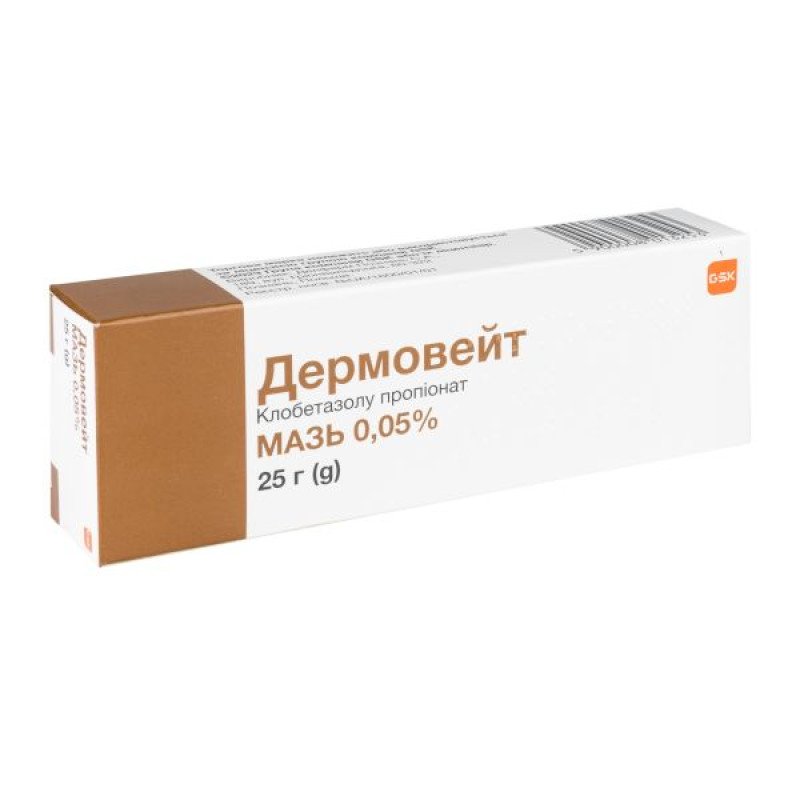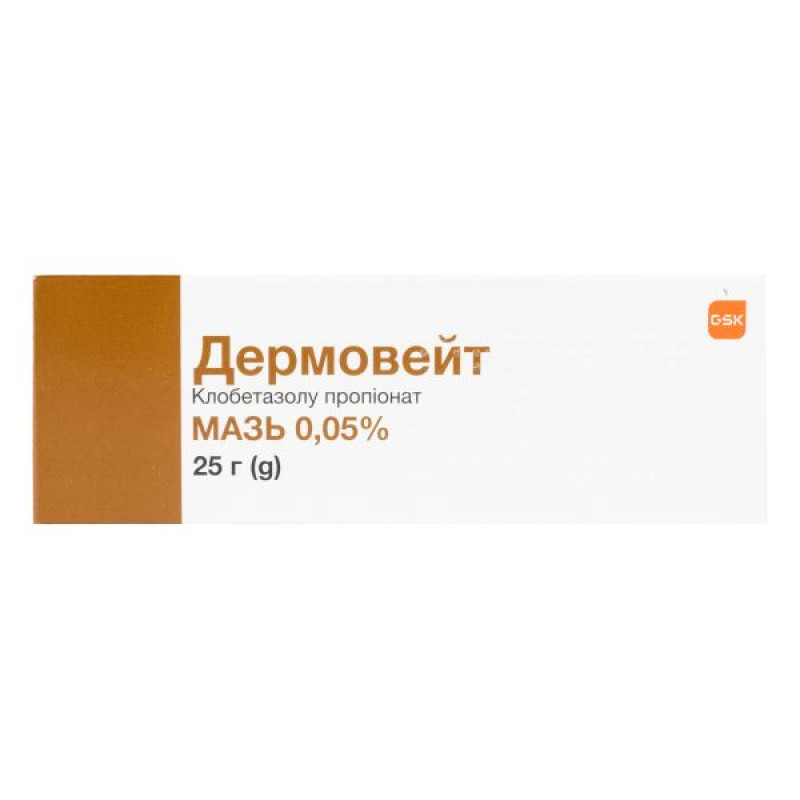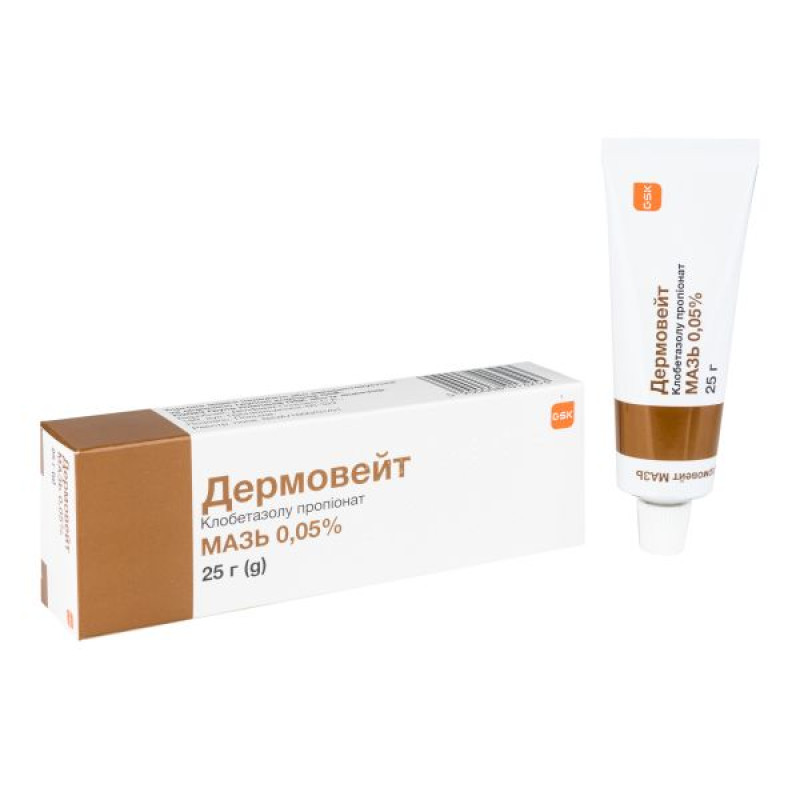Dermoveit ointment 0.05% tube 25 g

Instructions Dermovate ointment 0.05% tube 25 g
Composition
active ingredient: clobetasol propionate;
1 g of ointment contains 0.5 mg of clobetasol propionate;
Excipients: propylene glycol, white soft paraffin and sorbitan sesquioleate.
Dosage form
Ointment.
Main physicochemical properties: homogeneous white translucent ointment, free from undispersed particles and foreign inclusions.
Pharmacotherapeutic group
Corticosteroids for topical use. Highly active corticosteroids. ATX code D07A D01.
Pharmacological properties
Pharmacodynamics.
The main effect of clobetasol propionate on the skin is a nonspecific anti-inflammatory effect due to vasoconstriction and reduced collagen synthesis.
Pharmacokinetics.
The penetration of clobetasol propionate through the skin varies between individuals and may be increased by the use of occlusive dressings or by inflammation or skin damage. In subjects with healthy skin, a mean peak plasma concentration of clobetasol propionate of 0.63 ng/mL was observed in one study 8 hours after the second application (13 hours after the first application) of 30 g of 0.05% clobetasol propionate ointment. After a second dose of 30 g of 0.05% clobetasol propionate cream, the mean peak plasma concentration was slightly higher than that after the ointment application and was observed 10 hours later. In another study, mean peak concentrations (approximately 2.3 ng/mL and 4.6 ng/mL) were observed in psoriasis and eczema patients, respectively, 3 hours after a single application of 25 g of 0.05% clobetasol propionate ointment. After absorption through the skin, the drug most likely undergoes the same metabolic pathway as corticosteroids after systemic administration. However, the systemic metabolism of clobetasol has not been fully established.
Indication
Clobetasol is a highly potent topical corticosteroid that is prescribed to adults, the elderly, and children over 1 year of age for short-term treatment of relatively more persistent inflammatory and pruritic manifestations of steroid-sensitive dermatoses that are insensitive to less potent corticosteroids.
Such diseases are:
- psoriasis (except widespread plaque psoriasis);
- dermatoses that are difficult to treat;
- red lichen planus;
- discoid lupus erythematosus;
- other skin diseases that are not treatable with less active corticosteroids.
Contraindication
- Hypersensitivity to any components of the drug.
- Untreated skin infections.
- Rosacea.
- Common acne.
- Itching without inflammation.
- Perianal and genital itching.
- Perioral dermatitis.
- Dermovate is not intended for the treatment of dermatoses in children under 1 year of age, including dermatitis and diaper rash.
Interaction with other medicinal products and other types of interactions
Concomitant use with drugs that may inhibit CYP3A4 (e.g. ritonavir, itraconazole) has been shown to inhibit the metabolism of corticosteroids, which may increase systemic exposure. The extent to which this interaction is clinically significant depends on the dose of the drug, the route of administration of the corticosteroid, and the potency of the CYP3A4 inhibitor.
Application features
Cases of serious osteonecrosis (including necrotizing fasciitis) and systemic immunosuppression (sometimes leading to reversible Kaposi's sarcoma) have been reported with prolonged use of clobetasol propionate at doses higher than those recommended (see section 4.2). In some cases, patients were receiving concomitant treatment with other potent oral/topical corticosteroids or immunosuppressants (e.g. methotrexate, mycophenolate mofetil). If treatment with topical corticosteroids for more than 4 weeks is clinically warranted, consideration should be given to using a less potent corticosteroid.
The drug should be used with caution in patients with a history of local hypersensitivity reactions to corticosteroids or any of the excipients. Local hypersensitivity reactions (see section "Adverse reactions") may resemble the symptoms of the disease being treated.
Manifestations of hypercorticism (Cushing's syndrome) and hypothalamic-pituitary-adrenal (HPA)-adrenal axis suppression with adrenal suppression in some individuals may result from increased systemic absorption of topical steroids. If any of the above symptoms occur, the drug should be gradually discontinued by reducing the frequency of application or by switching to a less potent corticosteroid. Abrupt discontinuation of treatment may result in glucocorticosteroid insufficiency (see section "Adverse Reactions").
Risk factors for systemic effects include:
- the potency and composition of the topical steroid;
- duration of use;
- application to a large area of skin;
- application on skin surfaces that touch, for example, in diaper areas or where an occlusive dressing is applied (in infants, diapers can play the role of an occlusive dressing);
- increased hydration of the stratum corneum;
- use on areas of damaged skin or in other conditions where the skin barrier is disrupted.
- Children may absorb proportionally greater amounts of topical corticosteroids than adults and are therefore more susceptible to systemic side effects. This is because children have an immature skin barrier and a larger skin surface area relative to body weight than adults.
Children
Long-term use of topical corticosteroids in infants and children under 12 years of age should be avoided where possible, as they are more likely to develop adrenal suppression.
Children are more susceptible to the development of atrophic changes when using topical corticosteroids. Treatment with Dermovate in children should, if possible, last no more than 5 days. The feasibility of continuing treatment should be reviewed weekly. Dermovate is not used in children under occlusive dressings.
Risk of infection when applying an occlusive dressing
The risk of bacterial infections increases in warm and humid conditions, particularly under occlusive dressings, so the skin should be thoroughly cleaned before applying an occlusive dressing each time.
Psoriasis treatment
Topical corticosteroids should be used with caution in the treatment of psoriasis, as in some cases relapses, development of tolerance, risk of generalization of pustular psoriasis and development of symptoms of local or systemic toxicity due to impaired skin barrier function have been reported. When used for the treatment of psoriasis, the patient should be under close medical supervision.
Concomitant infections
Appropriate antibacterial agents should be administered whenever inflammatory infected lesions are treated. In the event of spread of infection, topical corticosteroids should be discontinued and appropriate antibacterial therapy should be administered.
Chronic leg ulcers
Topical corticosteroids are sometimes used to treat dermatitis around chronic leg ulcers. However, this use is associated with an increased incidence of local hypersensitivity reactions and an increased risk of local infections.
Applying ointment to the face
Applying the ointment to the skin of the face is undesirable, as this area is more prone to atrophic changes. If necessary, use should be limited to 5 days.
Application to the eyelids
When applying the ointment to the eyelids, avoid getting the drug in the eyes, as repeated use may cause cataracts and glaucoma.
Vision impairment
Visual disturbances have been reported with systemic and topical corticosteroids. If a patient presents with symptoms such as blurred vision or other visual disturbances, they should be referred to an ophthalmologist for evaluation of possible causes, which may include cataracts, glaucoma, or rare conditions such as central serous chorioretinopathy, which have been reported with systemic and topical corticosteroids.
Dermovate ointment contains 475 mg of propylene glycol per 1 g of the product. Propylene glycol may cause skin irritation.
Dermovate ointment contains paraffin. Patients should be warned not to smoke or be near fire due to the risk of severe burns. If the drug comes into contact with fabric (clothing, bedding, bandages, etc.), the material can easily ignite and cause a serious fire. Washing clothes and bedding reduces the accumulation of the drug in the fabric, but does not completely remove it.
Use during pregnancy or breastfeeding.
Pregnancy
Data on the use of Dermovate in pregnant women are limited.
Topical administration of corticosteroids to pregnant animals may cause fetal harm. The relevance of these data to humans has not been established. Clobetasol should be used in pregnancy only if the expected benefit to the mother justifies the potential risk to the fetus. The minimum amount of the drug should be used for the shortest duration of treatment.
Breast-feeding
The safety of clobetasol propionate during breastfeeding has not been established. It is not known whether topical corticosteroids can result in systemic absorption that would result in measurable amounts of the drug in breast milk. Dermovate should be used during breastfeeding only if the expected benefit to the mother outweighs the risk to the infant. If prescribed during breastfeeding, the ointment should not be applied to the breasts to avoid accidental ingestion of the ointment by the infant.
The ability to influence the reaction speed when driving vehicles or other mechanisms.
No studies have been conducted to study this effect. Given the adverse reaction profile, no effect on the reaction rate when driving or operating other mechanisms is expected.
Method of administration and doses
Clobetasol propionate belongs to the class of the most potent topical corticosteroids (group IV) and its prolonged use may lead to serious undesirable effects (see section "Special instructions for use"). If treatment with a topical corticosteroid is clinically justified after 4 weeks of use, the possibility of prescribing a less potent corticosteroid should be considered. Repeated but short courses of therapy with clobetasol propionate can be used to control exacerbations (see details below).
The ointment is particularly suitable for the treatment of skin lesions accompanied by dryness, lichenification or peeling.
The ointment is gently applied in a thin layer, covering all affected areas of the skin, 1 or 2 times a day until clinical improvement occurs (if there is a good response to treatment, improvement is achieved in a few days), then the frequency of application is reduced or the drug is changed to a less potent one. After each application of the ointment, wait a certain time until it is completely absorbed before applying an emollient.
If worsening or no improvement occurs within 2–4 weeks, the diagnosis and treatment should be reviewed.
Repeated short courses of Dermovate may be used to control flare-ups. Treatment should not exceed 4 weeks. If continued long-term treatment is required, less potent drugs should be used.
The maximum weekly dose should not exceed 50 g.
When disease control is achieved, clobetasol should be gradually discontinued, and emollients should be continued as maintenance therapy.
Recurrence of symptoms of previous dermatoses is possible with sudden withdrawal of clobetasol.
In the case of more persistent lesions, especially with hyperkeratosis, the effect of Dermovate can be enhanced by covering the affected area of skin with an occlusive polyethylene dressing. Usually, applying the occlusive film only overnight will be sufficient to achieve a satisfactory result. The improvement achieved is usually maintained by applying the ointment without the use of an occlusive dressing.
For topical use.
Dermatoses that are difficult to treat. Patients with frequent exacerbations of the disease.
Once a continuous course of topical corticosteroid has been achieved during the acute phase of the disease, intermittent use (once daily, twice weekly, without occlusive dressing) should be considered. This treatment has been shown to be effective in reducing the frequency of exacerbations.
The drug should be continued to be applied to all previously affected areas of the skin or to known areas of potential exacerbation. This regimen should be combined with continued daily use of emollients. The clinical status and the benefits and risks of continued treatment should be regularly assessed.
Children.
The drug is contraindicated for the treatment of dermatoses, including dermatitis, in children under 1 year of age.
Overdose
Symptoms.
With normal use, Dermovate can be absorbed in quantities sufficient to cause systemic effects. The likelihood of an acute overdose is very small, however, in case of chronic overdose or improper use, signs of hypercortisolism may occur.
Treatment.
In case of overdose, Dermovate should be gradually discontinued by reducing the frequency of application of the ointment or replacing it with a less potent corticosteroid due to the risk of glucocorticosteroid insufficiency.
Further treatment should be carried out according to the patient's clinical condition or according to national guidelines for the treatment of poisonings (if available).
Side effects
Adverse reactions, information on which is provided below, are classified by organ system and by frequency of occurrence: very common ≥ 1/10, common ≥ 1/100 and < 1/10, uncommon ≥ 1/1000 and < 1/100, rare ≥ 1/10000 and < 1/1000, very rare < 1/10000, including isolated cases.
Infections and infestations
Very rare: opportunistic infections.
Immune system
Very rare: hypersensitivity, generalized rash.
Endocrine system
Very rare: hypothalamic-pituitary-adrenal axis suppression: Cushingoid features (e.g., crescent face, central obesity), weight gain/growth retardation in children, osteoporosis, hyperglycemia/glucosuria, hypertension, weight gain/obesity, decreased endogenous cortisol levels, alopecia, hair fragility.
Skin and subcutaneous tissue
Common: itching, local burning sensation/pain in the skin.
Uncommon: local skin atrophy*, atrophic skin streaks*, telangiectasias*.
Very rare: skin thinning*, skin wrinkling*, skin dryness*, pigmentation changes*, hypertrichosis, exacerbation of underlying symptoms, allergic contact dermatitis/dermatitis, pustular psoriasis, erythema, rash, urticaria, acne.
*Skin disorders secondary to local and/or systemic hypothalamic-pituitary-adrenal suppression.
General disorders and administration site conditions
Very rare: irritation/pain at the application site.
Organs of vision
Very rare: glaucoma, cataract.
Not known: visual impairment.
Expiration date
2 years.
Storage conditions
Store below 30 °C. Keep out of the reach of children.
Packaging
25 g of ointment in an aluminum tube with a polypropylene cap, 1 tube in a cardboard box.
Vacation category
According to the recipe.
Producer
Delfarm Poznań S. AND. , Poland/
Delpharm Poznan SA, Poland.
Location of the manufacturer and its business address.
189, Grunwaldska Street, 60-322 Poznań, Poland/
189, Grunwaldzka Str. , 60-322 Poznan, Poland.
There are no reviews for this product.
There are no reviews for this product, be the first to leave your review.
No questions about this product, be the first and ask your question.








